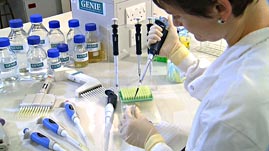Teachers' Domain - Digital Media for the Classroom and Professional Development
User: Preview




Measuring and dispensing small volumes of a variety of liquids is a critical part of many biology and chemistry laboratory procedures. The smaller the volumes, the more difficult this is, and the more important it is to do so accurately and precisely. Micropipettes are sophisticated instruments designed specifically to measure and dispense small volumes. This video, adapted from the University of Leicester, describes the basic function of a variety of micropipettes. It also demonstrates their proper use and the errors that can result if proper techniques and procedures aren’t followed.
Pipettes are tools commonly used in molecular biology and chemistry labs. Their purpose is to accurately measure and dispense volumes of liquid, sometimes as little as one microliter (one-thousandth of a milliliter). Working with such minuscule volumes would otherwise present serious challenges to scientists and lab technicians; not only is it impossible to pour a few microliters of liquid into a graduated cylinder, but small measurement errors can have huge consequences when measuring tiny volumes. Pipettes provide a solution to these problems but only if they are used properly.
Pipettes come in a variety of different forms. They vary in cost, construction, and function, as well as in the accuracy and precision of the measurements they provide. While the simplest pipettes are little more than large medicine droppers, the majority of pipettes used in labs today are far more sophisticated and deliver much better results.
The most common digital micropipettes measure volumes between two microliters and a thousand microliters. Typically, these instruments are designed to measure and deliver volumes within a narrow range. For example, a P20 micropipette accurately measures volumes between two and twenty microliters. If you wish to measure a volume outside of this range—either more or less—it is necessary to use a micropipette designed for that volume. Choosing the micropipette that is in the appropriate range for the volumes you wish to measure is extremely important. It will ensure accurate and precise measurements, and also keep these important lab instruments in good working order; attempting to set a micropipette for a volume outside of its intended range can break the instrument.
Attaining accurate and precise volume measurements is the primary reason for using such sophisticated, and often expensive, instruments. Although the terms accuracy and precision are often used in the same context, their meaning is not the same. Accuracy is defined as the difference between the desired volume and the actual volume dispensed. Precision refers to the consistency of multiple measurements. In other words, on one hand, it is possible to obtain an accurate measurement—to dispense exactly the volume that was intended—but if this measurement cannot be consistently reproduced, the technique lacks precision. On the other hand, it is possible to be precise—to obtain the same measurement time after time—but to be inaccurate with every measurement.
While small differences in accuracy might be less important when working with relatively large volumes, small errors made while working with tiny volumes can negatively impact results. Take, for example, a measurement error of 0.2 microliters. An error of this size made while dispensing into a solution of 1,000 microliters would represent only 0.02 percent of the total volume. The same error made while dispensing into a volume of 5 microliters would represent four percent of the total volume, and would be much more likely to affect results negatively. Avoiding such errors is why scientists and lab technicians are careful to follow proper micropipetting techniques, like those demonstrated in this video.
 Loading Standards
Loading Standards